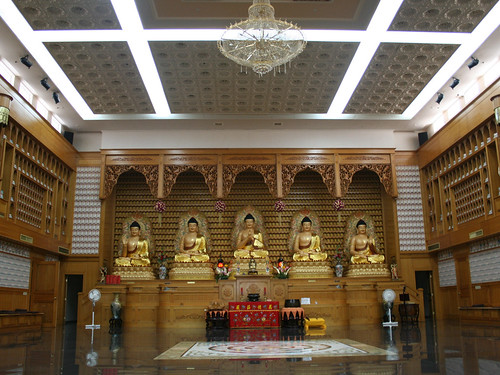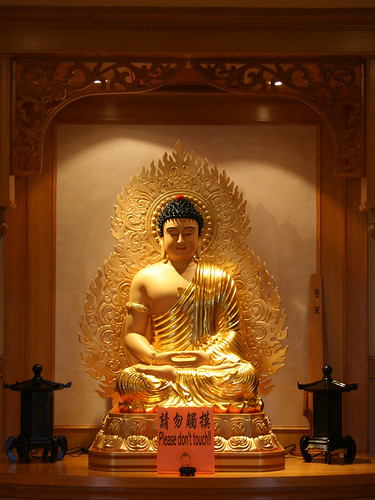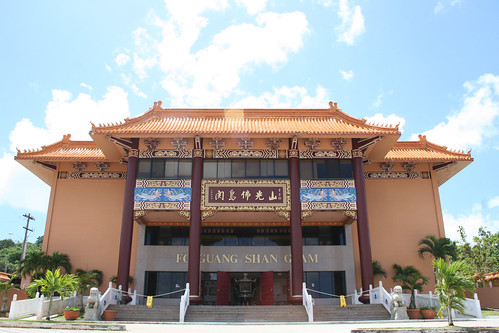Guam Buddhism Society
Fo Guang Shan Guam
The Guam Buddhism Society, the non-profit community organization associated with Guam’s Fo Guang Shan Buddhist Temple, was founded in 1986 and has built the only traditional Mahayana Buddhist temple in Guam. The temple, located off Bello Road near the Guam International Airport, is a monumental blend of the Chinese palatial style and the style of a traditional Buddhist temple.
The members of Guam’s Fo Guang Shan Buddhist Temple are also associated with the Buddha’s Light International Association (BLIA). The BLIA was founded by Fo Guang Shan founder Venerable Master Hsing Yun in order to create a global perspective for promoting Buddhism. BLIA now includes more than 100 Buddhist chapters from around the world.
Ven. Master Hsing Yun founded the Fo Guang Shan order in 1967, and since then it has evolved from a mountaintop bamboo forest to the largest Buddhist monastery in Taiwan, inspiring over 1,000 monastics. Fo Guang Shan now has over 200 branch temples throughout the world carrying out the goals of propagating Humanistic Buddhism and establishing a Pure Land on earth.
Although many members of Fo Guang Shan Guam are Chinese, there are also many other members from different ethnicities, including Chamorros, Filipinos, Japanese, Malaysians, Koreans, Singaporeans and others.
The Guam Buddhism Society is very active, holding not only Sunday ceremonies and meditation classes during the week, but special services for sick or deceased loved ones in Guam and for those suffering around the world. The members also have special ceremonies on other occasions, including Buddha’s birthday and other special occasions. Members also celebrate Chinese New Year with festivals, hold recreational and spiritual classes, attend special lectures by Buddhist Shi Fu, or teachers, from Taiwan, attend international Buddhist conferences, and take an active role in many local civic activities.
Compassionate works
The members of the society promote the compassionate values of Buddhism through a large number of activities that help others in need.
The members of Fo Guang Shan Guam and BLIA, Guam have taken part in Guam Beautification Day, cleaning up Ypao Beach Park and other beaches; they held a Buddhist Releasing-Souls-from-Suffering ceremony near the tragic Korean Airline crash site in 1997; and they have repeatedly helped those in need after disasters.
Some of their humanitarian efforts include:
- 1993, after the volcano eruption in the Philippines, BLIA, Guam launched a donation drive for clothing and daily necessities for the victims
- 1996, when Typhoon Herbert caused serious floods in Taiwan, BLIA, Guam joined the relief activities and raised money for the victims
- 1997, Fo Guang Shan Guam held relief activities after Supertyphoon Paka devastated Guam and caused island-wide power and water outages
- 1998, Hurricane Mitch devastated Central America, and BLIA, Guam joined the relief efforts
- 2004, Fo Guang Shan Guam members were instrumental in raising funds for the victims of the tsunami disasters in southeast Asia
- 2005, Fo Guang Shan Guam also played a key part of Guam’s relief efforts for the Hurricane Katrina disaster victims in the US.
History in Guam
In 1986, Mrs. Chang Yao-Hong was ready to close her business in Guam and return to Taiwan. Mr. Feng Run-Chun, a local manager of her company, had a powerful dream the night before he was to return to Taiwan. In his dream, a Goddess of Mercy dressed in white is said to have visited him and told him:
Guam is lacking a religion: Buddhism. Please tell your boss.
Feng was shocked by the dream and immediately told his boss, Mrs. Chang, when he returned to Taipei.
Shortly after, Chang and Feng visited the Venerable Master Hsing Yun, the founder of Fo Guang Shan Monastery in Taiwan, who came to Guam to propagate Buddha’s teachings. Chang was willing to provide a single family house as a temporary temple, and it served as the Guam branch of the Fo Guang Shan Zen-Purification Center, established on 20 December 1986.
For more than 10 years, the society practiced and spread Buddha’s teachings in Guam, under the leadership of four Buddhist monks: Ven. Yi Quing, Yi Rai, Yi Hong and Ven. Man Yu. The members of the society quickly multiplied, making the original meeting place inadequate, and they soon started looking for a new home.
In 1989, about 6,600 square meters of farmland was purchased for the purpose of building a temple. However, because the land had to undergo a zone change from agricultural to religious use, countless public hearings were held, and the zone change wasn’t approved by the Guam Legislature until 1994.
Temple construction began 1 August 1996, under Ven. Man Yu’s supervision, and it was completed in two years at a cost of about four million dollars. The temple held a grand opening ceremony 3 April 1999, attended by Ven. Master Hsing Yun and other venerables.
Temple
The Fo Guang Shan Guam temple was given the top award for Guam’s most beautiful buildings in 2000 and 2001 by the Guam Beautification Task Force before the award was discontinued.
Due to the slumping economy in Guam, donations to the society have decreased, making it difficult to maintain such a large and elaborate building, however the temple remains a striking piece of architecture and a first-class home for those who wish to learn about or practice Buddhism.
The exterior of the temple takes on the form of a traditional Buddhist temple, with a gold Chinese-pogoda roof and large columns at the front of the temple. Elaborate decorations surround the imposing three-story structure, and a large welcoming staircase leads up to the front entrance.
Inside on the first floor visitors are greeted by a prominent statue of Avalokitesvara Bodhisattva (in the Pali language of early Buddhism). In Chinese, this representation is known as Kuan Yin. Avalokitesvara can be loosely translated as “the compassionate sage who sees and hears all,” referring to this bodhisattva’s ability to perceive all the suffering in the world and thus come to people’s aid. Bodhisattva refers to one who has sought and attained self-liberation or enlightenment, practicing all perfections, but chooses to remain in the world to help others achieve Buddhahood. The gift shop sells incense, books on Buddhism and meditation, small Buddha statues and jade carvings. A large meditation room is at the center of the first floor, and the abbeys and venerables conduct meditation sessions and classes for beginners here. Also on the first floor are a tea room, a library with a large collection of books on Buddhism in Chinese and English, a calligraphy room, a conference room and a luncheon hall.
The crowning glory of the temple, though, is the Main Shrine on the second floor which can accommodate 500 people for services. The shrine’s ceiling actually rises two floors, and the great room is filled with thousands of carvings of the Buddha. Five large statues of Buddha sit at the front of the shrine and many smaller ones surround them. Thousands of Buddhas are also carved into the wall tiles and ceiling. The members of the Guam Buddhism Society meet every Sunday in the shrine for traditional Buddhist services, with chanting of Buddhist sutras led by the venerables and accompanied by the rhythms of drums, bells and a gong. Afterward, the community gathers for a vegetarian lunch downstairs.
On the third floor is a world-class conference room, equipped with state-of-the-art sound and video technology, and an incredible view of Guam and the ocean.
For further reading
BuddhaNet – Worldwide Buddhist Information and Education Network. “buddhanet.net.” Last modified 12 January 2019.
Essentials of Buddhism. “Core Concepts.” Last modified 5 October 2011.
Fo Guang Shan Monastery Worldwide Web. “Home.” 2013.





